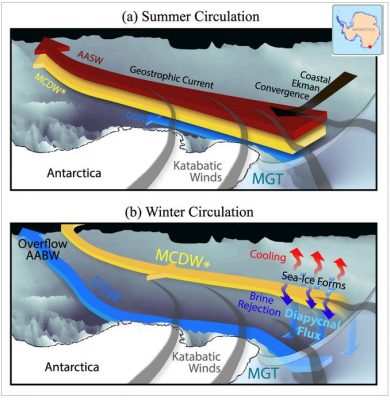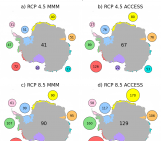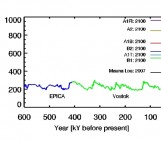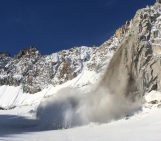
Antarctica is separated from the deep Southern Ocean by a shallow continental shelf. Waters are exchanged between the deep ocean and the shallow shelf, forming the Antarctic cross-shelf circulation:
- Very dense waters leave the shelf as Antarctic Bottom Water (AABW) that will then flow at the bottom of all oceans.
-
Meanwhile, relatively warm water from the Southern Ocean, Modified Circumpolar Deep Water (MCDW*) comes on the continental shelf and brings heat to the ice shelves.
That is, Antarctic cross-shelf circulation influences the water mass that transports heat, carbon and nutrient all around the globe in very large volumes (Purkey and Johnson 2013), and the basal melting of Antarctic floating ice (Hellmer et al. 2012), hence the stability of the whole Antarctic ice sheet.
Although critical for both the ocean and the cryosphere, very little is known about the mechanisms behind cross-shelf circulation. We know that the mechanisms that control it vary on a seasonal time scale (Snow et al. 2016b). However, most hydrographic observations around Antarctica are taken in summer, when there is less sea ice and when the Southern Ocean is the least stormy. This means that we have very few measurements of the seasonal variations of the cross-shelf circulation itself.
Why does it matter that the cross-shelf circulation varies between summer and winter?
Three words: sea level rise.
Nearly half of the world’s population lives in coastal areas (UN report). Antarctica contains enough ice to raise the sea level by 60 m, and although a total melting is very unlikely, current rates could raise the sea level by 1m by 2100 (read more about it on AntarcticGlaciers.org). To project future sea level rise and design relevant coastal defences, we need models to predict when and where the Antarctic ice will melt.
However, models are only as good as the observations that were used to constrain them. Having only summer observations in an area of Antarctica that has notable differences between summer and winter ocean circulation means that until now, models could not represent accurately the transfer of heat from the ocean to the ice shelves
A better observation strategy is needed if we want our models to correctly represent Antarctic basal melting and the global ocean circulation.
Antarctic cross-shelf circulation: summer vs winter
In summer, the circulation is mostly controlled by the strong katabatic winds blowing from the interior of the Antarctic continent towards the ocean. All the surface water masses go in the same direction, simply following the Antarctic coastal current. Nothing really happens at depth.
In winter, the circulation is also controlled by buoyancy forcings, that is changes in temperature or salinity at the surface of the ocean. Here, these mostly occur in a polynya (a hole in the sea ice cover) where the “warm” ocean is cooled by the very cold atmosphere, and where the surface becomes very salty as sea ice reforms (a process called “brine rejection”: salt is expelled from the new ice as water freezes). These buoyancy forcings form dense water (DSW), which sinks to the abyss and off the shelf as AABW. Mass conservation means that something else (here MCDW*) needs to come to the shelf to compensate for that outflow. You can notice that MCDW now flows in the opposite direction than it did in summer.
Take home message
Summer data is better than no data. But always be aware of the limitations of your model if you don’t have the datasets to test it– you may have a surprise when you do!
Reference
Snow, K., B. M. Sloyan, S. R. Rintoul, A. McC. Hogg, and S. M. Downes (2016), Controls on circulation, cross-shelf exchange, and dense water formation in an Antarctic polynya, Geophys. Res. Lett., 43, doi:10.1002/2016GL069479.
Edited by Sophie Berger and Emma Smith





Jason
Anymore interesting things like this please post to me, I feel most people would like to know much more (to everything) about these icebergs. I mean if anyone saw this they might think someone had a accident or something, so might radio it in to get help, so waste time on things, and maybe go closer to have a better look, where it might catch the ship going to see what the red colour is. Although I only just happened to see this and have more important things to get done, you get the idea what I mean.
From Jason